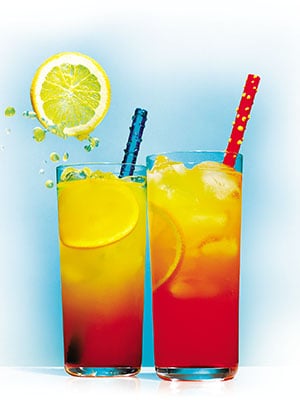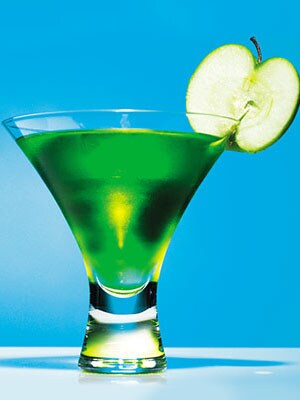Cocktails and the Science of Sipping
Tales of the cocktail pushes back the frontiers of sipping science


Dave Arnold, the director of culinary technology at the French Culinary Institute, is standing in front of about 150 people in a hotel ballroom, holding up both hands like a traffic cop. “Do not drink the cocktail that is coming around right now,” he says firmly. “It could be really, really dangerous!” The audience is attentive, not the least because Arnold employs a tone of voice that, in other circumstances, might suggest the inadvertent release of anthrax.
The drink being served on trays is a Sazerac, a cocktail of a great renown in New Orleans, which happens to be where Arnold is appearing as part of a panel at Tales of the Cocktail, a five-day conference of mixology and spirits. Actually, two very different Sazerac cocktails are coming around. One has been chilled the usual way, having been gently stirred with ice. The other—the dangerous one—has been chilled with liquid nitrogen into a sinister sort of smoking Slurpee.
This seminar is called ‘The Science of Stirring’. One wouldn’t think there would be all that much to say about stirring—throw together liquor and ice, stir, pour. But one would be wrong. Bartenders talk about ice and chilling like obsessive chefs talking about baking and braising. How much you chill (which affects dilution) changes the taste of what you drink. “It’s not simple,” says Arnold of the many variables in making a cocktail. “It’s not even in the realm of easy.”
The point of the dual Sazeracs is to demonstrate how a single drink can vary depending on temperature. Once the sinister Sazerac ceases to be life-threatening, we sample both versions.
The superchilled drink lacks the nuance and complexity of the stirred drink. It’s like a large, melodious bird that can sing just one note. The other, in contrast, is a forest filled with small, happily chirping birds.
Tales of the Cocktail is held in New Orleans each July, and it attracts many of those high-achieving bartenders you see quoted in the glossy magazines on matters related to contemporary adult beverages. Eighteen thousand or more participants show up here to expand their repertoire, check out what the others are up to, compare notes on trends, and bone up on physics, history, and shaker technique.
Their presence, in turn, attracts high-end liquor brand representatives, who hope these bartenders will stock their products, since they will in turn serve them to trendsetting customers. These customers, in turn, will artfully belittle their officemates for never having heard of, say, a wild damson plum gin. Their officemates will then go out and buy damson plum gin to impress their neighbours. Et cetera. This is how the wet is won.
Tales (as everyone refers to it) is sort of a combination of graduate school, summer camp, and a party for ultra-marathon tipplers. And—good news!—it’s not open only to the trade. The seminars and tastings, and most other events, are open to anyone who wants to pony up a few dollars. If you’ve been semiserious about making cocktails at home, Tales is the place to lose the ‘semi’. It’s like a fantasy baseball camp, where you get to play ball with the best in the world. It’s just that instead of a bat, you get a muddler. MANGO SUNRISE
MANGO SUNRISE
2 oz Sauza Hornitos Reposado tequila
6 oz fresh or bottled mango juice Thin slices of orange for garnish
1 oz grenadine
Fill a cocktail shaker half full of ice. Pour tequila and mango juice and stir to combine and chill. Fill a collins glass half full with ice. Slip an orange slice or two against the inside of the glass. Strain tequila mixture into the glass and pour in grenadine in a steady, slow stream. Do not stir. The grenadine will sink to the bottom and gradually rise.
BLUE KUMQUAT
2 oz clementine vodka
1 oz blue curaçao liqueur
Dash of orange bitters
Kumquats or orange peel for garnish
Fill a shaker half full of ice. Pour in vodka, curaçao, and bitters. Stir and strain into a cocktail glass. Garnish with kumquats skewered on a cocktail pick or with an orange peel spiral.
A few days of sitting in on seminars at Tales is the equivalent of getting a multidisciplinary education from the University of Drink. Here are some things I learnt in class:
History
“Five years ago you could not get 100 people to a seminar on the history of bar tools,” said barware manufacturer Michael Silvers at ‘The History of Bar Tools and Barware from the 1880s to Today’. That is plainly no longer true. A hundred and fifty people directed rapt attention to the humble bar spoon. Where did the twist in the stem come from? Why did it persist? No one really knows. Interesting fact: Japanese barware has remained fundamentally unchanged since the 1920s, and was originally based on American barware from the 1880s. So, to drink in Japan today is to revisit historic America.
Biology
Spirits expert Paul Pacult led a 90-minute seminar on how to taste liquor. “Taste is the affirmation of smell,” he said. We tasted each of five spirits twice, first to rinse our mouths, the second to actually taste, both times spitting out. Pacult says he does his tastings first thing each morning, before his taste buds are corrupted with food or coffee, when, he says, “my senses are their most acute”. The seminar was held at 10.30 am.
Chemistry
Fresh egg whites are added to many shaken cocktails to create a dense and pleasing foaminess. There was much discussion as to why gelatin doesn’t work as well—something about protein bubbles and chemical bonds. Fortunately, more drinks were served before the discussion progressed too far. Also, attendees learnt that egg whites shaken with citrus juice can produce a chemical reaction that may lead to shaker detonations.
PHYS ED
Several seminars focussed on efficiency and grace behind the bar—think of it as ballet for bartenders. Bar consultant Stanislav Vadrna spent time in Japan, studying the fluid motions of sushi chefs and bartenders. Vadrna pushed our class to strive for elegance (which he pronounced “el-a-jance”) and to project an ineffable nonchalance. We trained using cocktail shakers containing 100 grams of rice. (Personal discovery: A roomful of people shaking rice is sort of relaxing and melodious, even when one’s physical condition tends toward the fragile.) “It’s not just about science,” Vadrna said. “It’s about presence.”
Presence notwithstanding, I found the science more fascinating—and the stirring seminar best captured the soul of Tales for me. It was like a look at a blacksmith’s shop where ‘geekiness’ is forged into ‘cool’.
“We have to define stirring,” Dave Arnold said at the outset. “It’s moving liquid through ice in a non-aggressive manner.” After comparing the Sazeracs, Arnold and his fellow panelists demonstrated exactly what happens inside a mixing vessel when stirred. They did this with thermocouples the precise temperatures within each of six vessels were projected in real time on a large screen. Shaking, it turns out, is the most efficient way to chill a drink—the temperature typically reaches equilibrium with just 17 seconds of brisk to-and-fro.
Yet, one doesn’t want to inflict that sort of violence on every cocktail—shaking also introduces air bubbles, which make the drink cloudy and changes the texture of a cocktail. Many drinks—the martini, the Manhattan, the Sazerac—are best served crystal clear, with the texture more like silk than burlap. What’s more, stirring lowers the temperatures more gradually, so the bartender has more control over the rate of chilling and dilution.
Then talk turned to precise stirring technique, about which there was little agreement on methodology, but general agreement on one point.
“If you can’t look cool while stirring,” said another panelist, Thomas Waugh of New York’s Death & Co, “your drink won’t have any deliciousness”.
Considerable nodding of heads ensued. THE BIG APPLE
THE BIG APPLE
2 oz Spirit of the Hudson New York
State apple vodka
1 oz Bauchant XO apple liqueur
1 oz fresh Granny Smith apple juice
Pour ingredients into a cocktail shaker half full with ice. Stir and strain into a cocktail glass. Garnish with apple slice.
VIOLET DENDROBIUM
Granulated sugar crystals
1/8 of a fresh lime
2 oz Bols Genever (or gin)
1 oz Crème de Violette
Dendrobium orchid blossom for garnish
Pour sugar crystals into a saucer large enough to accommodate the diameter of a cocktail glass. Run the cut part of the lime wedge around the rim of the glass and dip the glass into sugar to coat the rim. Fill a shaker half full of ice. Squeeze in remaining juice from the lime wedge and add Genever and Crème de Violette. Stir and strain into glass. Garnish.
Tales of the cocktail
Will be held from July 20–24 at the Hotel Monteleone in New Orleans’ French Quarter. Individual seminars cost $45 in advance a limited number of Founder’s Day passes, which include 14 seminars and several parties and events, cost $599 each. Multicourse cocktail pairing dinners run from $85 to $100. Many French Quarter hotel rooms are available at reduced rates during the summer doldrums. talesofthecocktail.com
First Published: Apr 16, 2013, 06:27
Subscribe Now